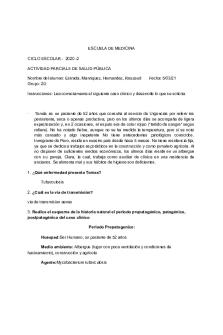2020BE311 5 SP Resit web PDF

| Title | 2020BE311 5 SP Resit web |
|---|---|
| Author | Diego Muñoz González |
| Course | Databases and Information Retrieval |
| Institution | University of Essex |
| Pages | 7 |
| File Size | 452.4 KB |
| File Type | |
| Total Downloads | 72 |
| Total Views | 152 |
Summary
2020BE311-5-SP-RESIT.pdf web application
web application programming essex university...
Description
BE311-5-SP-RESIT/1
UNIVERSITY OF ESSEX
SECOND YEAR EXAMINATION 2020
________________________________________________________________________________
CORPORATE FINANCE ________________________________________________________________________________
Time allowed: 24 hours Time to spend on your assessment: 2 hours Maximum word count for assessment: 2000 words Please see your exam timetable or check on FASER for the deadline to upload your answer. The times shown on your timetable are in British Summer Time (BST). Please check online for a conversion to your local time if you will be undertaking your assessment outside the United Kingdom The paper consists of FOUR questions. Candidates must answer TWO questions. All questions carry equal weight.
Candidates are permitted to bring into the examination room: Calculator – Casio FX-83GT PLUS/X or Casio FX-85GT PLUS/X only
You can add hand written answers for equations/mathematical questions (take a photo/scan and add to your document). You may also use Excel for equations and take screenshots (Ctrl+Alt+PrtScn) then paste into your document. Referencing and plagiarism Reference source material in the same way as you would in an exam: Use a few key names/themes/theories that support your argument or show your understanding of the subject Include names and dates where possible, though you won’t lose marks for not doing so Paraphrase where appropriate If you’re copying a quote directly from another source you must use quotation marks and ensure you reference correctly
BE311-5-SP-RESIT/2
If you have a query with the content of this exam paper contact [email protected] If you have a technical problem with FASER, or any other query, please go to Exams Website to find contact details of the teams that can help you. Please note that the time allocated for this assessment includes time for you to download this question and answer paper and to upload your question and answers paper to FASER. Please allow at least 30 minutes within your exam time to upload your work. Once you have completed the assessment do not leave it to the last minute to upload. Please save your work throughout the examination to avoid losing your work. Please do not communicate with any other candidate in any way during this assessment. Your response must be your own work. Procedures are in place to detect plagiarism and collusion.
BE311-5-SP-RESIT/3
QUESTION ONE The Vox Populi Corporation is planning an investment into the farming industry. The plan is to invest in farm land that has been used for genetically modified crops, with the aim of restoring the land to its original state so that it can once again be used for conventional crops. Each year the Vox Populi Co will commit to invest £0.5m in farm land. The cleaning process will take on average 5 years, at a cost of £100,000 each year. The expected sale price at the end of the 5-year period is £1.5m. The Company will repeat this process each year for ten years, so that the first batch of land is purchased in year 0 and the final batch is purchased in year 9. The beta for the investment is 1.3. The risk-free interest rate is 3% and the average return on the market index is 7%. a. What is the cost of capital for the Vox Populi Co’s investment plan? (5 marks) b. What is the net present value for the investment in year 0? (10 marks) c. What is the net present value for the investment over the full 10-year period? (15 marks) d. The Vox Populi Co has assumed that there is no need for working capital, but they realise that the cleaning process requires external contractors which will bind working capital to the operation. The working capital is 30% of the annual costs. What is the impact on your answer in (c) of the working capital investment? (20 marks) (TOTAL – 50 MARKS)
QUESTION TWO The Virile-Agitur Corporation (VA Co) is expecting its operations generate an annual cash flow of £20m for the foreseeable future. The beta of the firm is 1.4, the risk-free rate is 3%, and the average return of the market index is 7%. a. What is the cost of capital for VA Co? (5 marks) b. VA Co is adopting a capital structure where the debt-equity ratio is 2. What is the value of the firm’s debt and equity? (15 marks) c. Explain the trade-off theory of capital structure. (15 marks) d. Suppose that Modigliani-Miller Irrelevance of capital structure holds. If the firm reduces its borrowing to a debt-equity ratio of 1 such that the cost of debt capital is equal to 4%, what is the cost of VA Co’s equity capital? (15 marks) (TOTAL – 50 MARKS)
BE311-5-SP-RESIT/4
QUESTION THREE Consider a debt contract that promises a 5% annual coupon interest paid at the end of each year. The face value is £15m, which according to the debt contract should be paid at the end of year 10. The yield-to-maturity of the bond is 6%. a. What is the value of the bond? (10 marks) b. Explain what a sinking fund provision is. Suppose the debt contract states that the bond holders must repay £10m to a sinking fund at the end of year 5, and a final £5m to be paid at the end of year 10. What is the value of the bond now (you should assume that the yield-tomaturity remains at 6%)? (20 marks) c. Explain why bond holders worry about new issues of senior debt, secured debt, or long-term lease agreements. How do bond covenants restrict the firm’s actions in these areas? (20 marks) (TOTAL – 50 MARKS) QUESTION FOUR The Tempora-Heroic Corporation (TH Co) is considering a pay-out worth £10m to its shareholders. The equity is currently trading at a price of £120 per share, with 2.5m shares issued. a. Explain how stock repurchases and dividend schemes work. (10 marks) b. What is the expected pay-out per share? If the TH Co chooses a dividend pay-out scheme, what is the expected share price on the ex-dividend day? (10 marks) c. Now assume that the TH Co chooses a stock repurchase scheme. After the scheme is carried out, how many shares in total are left outstanding? (10 marks) d. Explain what roles taxes, transaction costs and signalling play in explaining the pay-out policy of a firm like the TH Co. (20 marks) (TOTAL – 50 MARKS)
END OF EXAMINATION PAPER PLEASE SEE NEXT PAGE FOR THE ANSWER SHEET
BE311-5-SP-RESIT/5
ANSWER SHEET (please use as many sheets as you need to) Please enter your Student Registration number here: 1900210 TYPE THE QUESTION NUMBER AND YOUR ANSWERS HERE
Question 1 a) To Calculate the cost of capital of the investment we should use the CAPM formulas: Cost of Capital = Risk Free Rate + Beta*(Expected return market index – Risk Free Rate) Cost of Capital = 0.03 + 1.3*(0.07 – 0.03) = 0.082
b) Due to in year 0 (year 1 in Excel table), the investment does not give any cash flow because the land is not ready to be sold and need 4 more years; the Present Value of the investment is 0 and we only take count of the costs: NPV = PV – I
NPV = 0 - 0,554528651 = -0,554528651
c)
The quantity of years of the investment is given by the number of years the company pay for the lands, but the profit of the investment is not complete until the last piece of land is cleaned, which means 5 years after the last purchase. The net present Value of the investment is £1,09506m, but if we want the net present Value of the 10 years period, we do not have to keep in mind years 11 to 14. So, the net present value over the 10 years period would be the sum of the NPV from year 1 to year 10. ∑ 𝟏𝟎 𝟏 𝐍𝐏𝐕𝐢 = -0,764382443
BE311-5-SP-RESIT/6
d)
The working capital would suppose an extra cost, so that means that the NPV of the investment would decrease from £1,09506m to £0,9287m. The net present value for the investment over the 10-year period is calculated as the sum of the NPV over years 1 to 10: ∑ 𝟏𝟎 𝟏 𝐍𝐏𝐕𝐢 = -0,930741038
BE311-5-SP-RESIT/7
Question 2 a) To calculate the cost of capital we use the formula: Cost of Capital = Risk Free Rate + Beta*(Expected return market index – Risk Free Rate) Cost of Capital = 0.03 + 1.4*(0.07 – 0.03) = 0.086
b) D/E = 2, this means that D = 2E. The sum of Debt and Equity should be the same amount as the assets, in this case the expected cash flow (£20m) E + D = 20000 => E + 2E = 20000 => Equity = 6666.67 and Debt = 13333.33
c) The Trade-off Theory was suggested by Mayer in 1984 and bases on MM Irrelevance theory. This theory suggests that there is an optimal capital structure that maximizes the value of the firm balancing the costs and benefits of an additional unit of debt. This optimal level of leverage is achieved by balancing the benefits from tax shield and cost of bankruptcy:
d) MMI Model affirms that even if the debt/equity ratio changes, the WACC would not change. So, the cost of capital will remain the same (0.086). As we know rA, rD and D/E we could use the leverage formula to calculate the cost of equity capital: rE = rA + Debt/Equity*(rA – rD) rE = 0.086 + 1/1*(0.086 – 0.04) = 0.132...
Similar Free PDFs

2020BE311 5 SP Resit web
- 7 Pages

5. SP
- 5 Pages

Welcome to ASUS Web Storage SP
- 6 Pages

BE131 Resit moderated Final
- 6 Pages

Lecture 5 - web security
- 50 Pages

Sp
- Pages

economics resit Exam 2015
- 2 Pages

Resit Course-work essay
- 4 Pages

SP - LAS 3 - Week 5-8 - Students
- 6 Pages

SP Pospatogenico
- 2 Pages
Popular Institutions
- Tinajero National High School - Annex
- Politeknik Caltex Riau
- Yokohama City University
- SGT University
- University of Al-Qadisiyah
- Divine Word College of Vigan
- Techniek College Rotterdam
- Universidade de Santiago
- Universiti Teknologi MARA Cawangan Johor Kampus Pasir Gudang
- Poltekkes Kemenkes Yogyakarta
- Baguio City National High School
- Colegio san marcos
- preparatoria uno
- Centro de Bachillerato Tecnológico Industrial y de Servicios No. 107
- Dalian Maritime University
- Quang Trung Secondary School
- Colegio Tecnológico en Informática
- Corporación Regional de Educación Superior
- Grupo CEDVA
- Dar Al Uloom University
- Centro de Estudios Preuniversitarios de la Universidad Nacional de Ingeniería
- 上智大学
- Aakash International School, Nuna Majara
- San Felipe Neri Catholic School
- Kang Chiao International School - New Taipei City
- Misamis Occidental National High School
- Institución Educativa Escuela Normal Juan Ladrilleros
- Kolehiyo ng Pantukan
- Batanes State College
- Instituto Continental
- Sekolah Menengah Kejuruan Kesehatan Kaltara (Tarakan)
- Colegio de La Inmaculada Concepcion - Cebu





